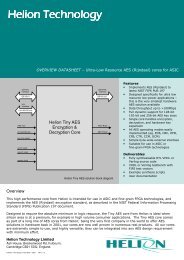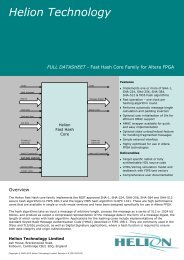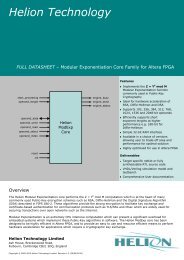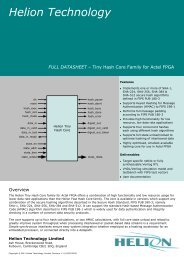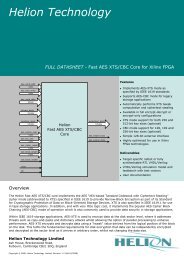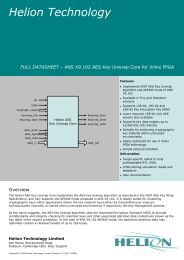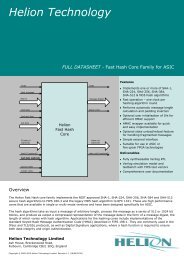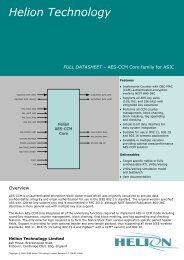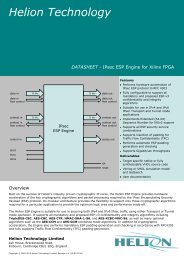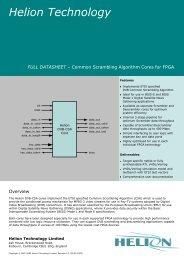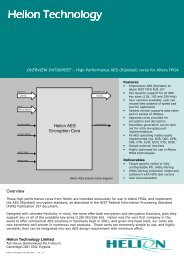Tiny Hash SHA-1, SHA-256, SHA-384, SHA-512, MD5 Lattice FPGA ...
Tiny Hash SHA-1, SHA-256, SHA-384, SHA-512, MD5 Lattice FPGA ...
Tiny Hash SHA-1, SHA-256, SHA-384, SHA-512, MD5 Lattice FPGA ...
You also want an ePaper? Increase the reach of your titles
YUMPU automatically turns print PDFs into web optimized ePapers that Google loves.
Helion Technology<br />
FULL DATASHEET – <strong>Tiny</strong> <strong>Hash</strong> Core Family for <strong>Lattice</strong> <strong>FPGA</strong><br />
Features<br />
Implements one or more of <strong>SHA</strong>-1,<br />
<strong>SHA</strong>-224, <strong>SHA</strong>-<strong>256</strong>, <strong>SHA</strong>-<strong>384</strong>,<br />
<strong>SHA</strong>-<strong>512</strong> & <strong>MD5</strong> hash algorithms<br />
Supports Keyed <strong>Hash</strong>ing for Message<br />
Authentication (HMAC) to FIPS 198-1<br />
clk<br />
a_reset<br />
mode<br />
hash_req<br />
hash_op<br />
host_read<br />
host_write<br />
host_data_in<br />
Helion <strong>Tiny</strong><br />
<strong>Hash</strong> Core<br />
queue_full<br />
digest_valid<br />
host_data_out<br />
Supports state unload/reload<br />
operations to optimise hashing of<br />
interleaved message streams<br />
Highly optimised for use in <strong>Lattice</strong><br />
<strong>FPGA</strong> technology<br />
Provides high functionality for low<br />
resource in low data rate applications<br />
Ideally suited for use as a hashing<br />
co-processor in embedded <strong>FPGA</strong><br />
applications<br />
Choice of 8 or 32-bit host system<br />
interface data bus width<br />
Deliverables<br />
Target specific netlist or fully<br />
synthesisable RTL VHDL/Verilog<br />
VHDL/Verilog simulation model and<br />
testbench with FIPS test vectors<br />
User documentation<br />
Overview<br />
The Helion <strong>Tiny</strong> <strong>Hash</strong> Core family for <strong>Lattice</strong> <strong>FPGA</strong> offers a combination of high functionality and low resource usage<br />
for lower data rate applications than the Helion Fast <strong>Hash</strong> Core family. The core is available in versions which support<br />
one or more of the five NIST approved cryptographic hashing algorithms described in FIPS 180-3; <strong>SHA</strong>-1, <strong>SHA</strong>-224,<br />
<strong>SHA</strong>-<strong>256</strong>, <strong>SHA</strong>-<strong>384</strong> and <strong>SHA</strong>-<strong>512</strong>, plus the legacy <strong>MD5</strong> algorithm described in RFC 1321.<br />
It can optionally support the standard Keyed <strong>Hash</strong>-based Message Authentication Code (HMAC) algorithm described in<br />
FIPS 198-1 which is widely used for data authentication and integrity checking in a number of data security protocols.<br />
Support for full hash state unload and reload also greatly improves system throughput when hashing interleaved or<br />
packetised message streams. A simple synchronous host system interface ensures easy connection into any end user<br />
application whether employed as a hardware hashing accelerator for an embedded processor, or connected directly<br />
into the datapath.<br />
Helion Technology Limited<br />
Ash House, Breckenwood Road,<br />
Fulbourn, Cambridge CB21 5DQ, England<br />
Copyright © 2010 Helion Technology Limited. Revision 1.0 (27/10/2010)
Functional Description<br />
The Helion <strong>Tiny</strong> <strong>Hash</strong> core family can be provided in versions which implement one or more of the NIST approved<br />
hashing algorithms specified in FIPS 180-3; namely <strong>SHA</strong>-1, <strong>SHA</strong>-224, <strong>SHA</strong>-<strong>256</strong>, <strong>SHA</strong>-<strong>384</strong> and <strong>SHA</strong>-<strong>512</strong> and also<br />
supports the legacy <strong>MD5</strong> hash algorithm to RFC 1321. In addition, each supported algorithm may be selected as the<br />
underlying hash function used to calculate the standard Keyed-<strong>Hash</strong> Message Authentication Code (HMAC) defined in<br />
FIPS 198-1.<br />
The core is able to switch mode dynamically between messages, allowing any hash algorithm (with or without HMAC)<br />
to be selected on a message by message basis. Additionally using the state unload/reload functionality, the core may<br />
also switch between messages on a block by block basis in order to facilitate efficient handling of multiple interleaved<br />
message streams which require independent authentication.<br />
For standard hash operations, the host loads message data into the core whenever the core indicates there is room in<br />
its message queue i.e. queue_full is deasserted. The core starts hash processing whenever a whole message block is<br />
available and the user has requested the hash operation defined by hash_op while asserting hash_req.<br />
Further message blocks may be loaded into the message queue by the host whilst the core is still busy processing<br />
previous blocks. Once hashing of the final message block is complete the core indicates that the message digest is<br />
valid by asserting digest_valid. The host system may then read the calculated message digest from the core before<br />
starting to process the next message.<br />
For HMAC operations, the host first loads the HMAC key into the core. The core then performs key pre-processing to<br />
ready itself for the subsequent hash operations, whilst the host is free to load the first blocks of message data. Once<br />
key pre-processing is complete, the core proceeds as described above for hash operations, with any additional<br />
internal HMAC processing hidden from the host. When the HMAC computation is complete the core indicates that the<br />
MAC result is valid by asserting digest_valid. The host system may then read the calculated MAC value from the core<br />
before starting to process the next message.<br />
Core versions<br />
The <strong>Tiny</strong> <strong>Hash</strong> core family provides a number of core versions, each sharing a common user interface whilst providing<br />
support for one or more hashing algorithms and optionally including HMAC processing.<br />
Measured minimum resource utilisation and maximum performance for <strong>Lattice</strong> <strong>FPGA</strong> are detailed for four versions of<br />
the core each including full support for HMAC in the tables below. The cores are available for current and legacy <strong>Lattice</strong><br />
<strong>FPGA</strong> devices; please contact Helion for further details of versions not shown in the tables.<br />
The core can be provided with host data interface widths of either 8 or 32 bits. As standard the core is supplied with a<br />
32 bit host data interface; all resource figures in the tables below assume this version.<br />
Logic Utilisation and Performance<br />
<strong>SHA</strong>-1<br />
<strong>SHA</strong>-224/<strong>256</strong><br />
technology<br />
ECP2/M -7<br />
ECP3 -8<br />
ECP2/M -7<br />
ECP3 -8<br />
logic resource<br />
tbd slices<br />
331 slices<br />
2 RAMs<br />
tbd slices<br />
421 slices<br />
2 RAMs<br />
max clock<br />
tbd MHz<br />
176 MHz<br />
tbd MHz<br />
158 MHz<br />
max <strong>SHA</strong>-1 rate<br />
tbd Mbps<br />
43 Mbps<br />
N/A<br />
N/A<br />
max <strong>SHA</strong>-224/<strong>256</strong> rate<br />
N/A<br />
N/A<br />
tbd Mbps<br />
37 Mbps<br />
max <strong>SHA</strong>-<strong>384</strong>/<strong>512</strong> rate<br />
N/A<br />
N/A<br />
N/A<br />
N/A
Logic Utilisation and Performance (continued)<br />
<strong>SHA</strong>-1/224/<strong>256</strong><br />
<strong>SHA</strong>-1/224/<strong>256</strong>/<strong>384</strong>/<strong>512</strong><br />
technology<br />
ECP2/M -7<br />
ECP3 -8<br />
ECP2/M -7<br />
ECP3 -8<br />
logic resource<br />
tbd slices<br />
485 slices<br />
2 RAMs<br />
tbd slices<br />
810 slices<br />
2 RAMs<br />
max clock<br />
tbd MHz<br />
155 MHz<br />
tbd MHz<br />
154 MHz<br />
max <strong>SHA</strong>-1 rate<br />
tbd Mbps<br />
38 Mbps<br />
tbd Mbps<br />
38 Mbps<br />
max <strong>SHA</strong>-224/<strong>256</strong> rate<br />
tbd Mbps<br />
36 Mbps<br />
tbd Mbps<br />
36 Mbps<br />
max <strong>SHA</strong>-<strong>384</strong>/<strong>512</strong> rate<br />
N/A<br />
N/A<br />
tbd Mbps<br />
26 Mbps<br />
About Helion<br />
Founded in 1992, Helion is a well established British company based in Cambridge, England, offering a range of<br />
product-proven Data Security IP cores backed up by highly experienced and professional design service capabilities.<br />
Although we specialise in providing the highest performance data encryption and authentication IP, our interest does<br />
not stop there. Unlike broadline IP vendors who try to supply a very diverse range of solutions, being specialists we<br />
can offer much more than just the IP core.<br />
For instance, we are pleased to be able to supply up-front expert advice on any security applications which might take<br />
advantage of our technology. Many of our customers are adding data security into their existing systems for the first<br />
time, and are looking for a little assistance with how best to achieve this. We are pleased to help with suitable advice<br />
and support where necessary, and pride ourselves in our highly personal approach.<br />
In addition, our Design Services team have an impressive track record in the development of real security products<br />
for our customers; we are proud to have been involved in the design of numerous highly acclaimed security products.<br />
This knowledge and experience is fed back into our IP cores, to ensure that they are easy to integrate into real<br />
systems, and perform appropriately for real engineering applications.<br />
Helion has a very long history in working with high performance <strong>FPGA</strong>s, so we take our <strong>Lattice</strong> implementations very<br />
seriously indeed. Our cores have been designed from the ground up to be highly optimal in <strong>Lattice</strong> <strong>FPGA</strong>; they are<br />
not simply based on a generic ASIC design like much of the competition.<br />
Most Helion IP cores make use of <strong>Lattice</strong>-specific architectural features; in fact in many cases we build-up custom<br />
internal logic structures by hand, in order to achieve the very highest performance and most efficient logic resource<br />
utilisation. The benefits of this dedicated approach can be clearly demonstrated by direct comparison between Helion<br />
Data Security IP cores and the equivalents from other vendors.<br />
More Information<br />
For more detailed information on this or any of our other products and services, please contact Helion and we will be<br />
pleased to discuss how we can assist with your individual requirements.<br />
Helion Technology Limited<br />
Ash House, Breckenwood Road,<br />
Fulbourn, Cambridge CB21 5DQ, England<br />
tel: +44 (0)1223 500 924<br />
fax: +44 (0)1223 500 923<br />
email: info@heliontech.com<br />
web: www.heliontech.com<br />
Copyright © 2010 Helion Technology Ltd; All rights reserved. This document contains Proprietary Trade Secrets of Helion Technology Limited; its receipt or possession does not<br />
convey any right to reproduce, disclose its contents, or to use its contents to manufacture, use, or sell anything that it may describe without the written authorisation of Helion<br />
Technology Limited. The products described in this document are subject to continuous development and all information is supplied strictly "as is" with no warranties implied or<br />
expressed and Helion Technology Limited shall not be liable for any loss or damage arising from the use of any information contained in this document.



